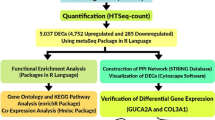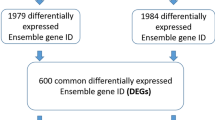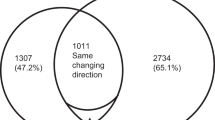Abstract
The progression of colorectal cancer (CRC) is a multistep process and metastatic CRC is always incurable; consequently, CRC is the leading cause of cancer-related deaths. There is therefore an urgent need for identifying useful biomarkers with enough sensitivity and specificity to detect this disease at early stages, which will significantly reduce the mortality for this malignancy. In this study, we performed an integrating analysis of different RNA-Seq data sets to find new candidate biomarkers for diagnosis, prognosis and as therapeutic targets for this malignancy, as well as to elucidate the molecular mechanisms of CRC carcinogenesis. We identified 883 differentially expressed genes (DEGs) across the studies between CRC and normal control (NC) tissues by combining five RNA-Seq data sets. Gene function analysis revealed high correlation with carcinogenesis. The top 10 most significantly DEGs were further evaluated by quantitative real-time polymerase chain reaction (qRT-PCR) in both rectal cancer (RC) and colon cancer (CC), and the results matched well with integrating data, suggesting that the method of integrating analysis of different RNA-seq data sets is acceptable. Therefore, integrating analysis of different RNA-seq data sets may be a useful way to overcome the limitation of small sample size in a single RNA-seq study. In addition, our study showed that some genes, such as SIM2, ADAMTS6, FOXD4L4 and DNAH5, may have an important role in the development of CRC, which could be applied for diagnosis, prognosis and as therapy for this malignancy. Our findings would also help to understand the pathology of CRC.
This is a preview of subscription content, access via your institution
Access options
Subscribe to this journal
Receive 12 print issues and online access
$259.00 per year
only $21.58 per issue
Buy this article
- Purchase on Springer Link
- Instant access to full article PDF
Prices may be subject to local taxes which are calculated during checkout




Similar content being viewed by others
References
Ferlay J, Shin HR, Bray F, Forman D, Mathers C, Parkin DM . Estimates of worldwide burden of cancer in 2008: GLOBOCAN 2008. Int J Cancer 2010; 127: 2893–2917.
Siegel R, Naishadham D, Jemal A . Cancer statistics, 2013. CA 2013; 63: 11–30.
Bass AJ, Lawrence MS, Brace LE, Ramos AH, Drier Y, Cibulskis K et al. Genomic sequencing of colorectal adenocarcinomas identifies a recurrent VTI1A-TCF7L2 fusion. Nat Genet 2011; 43: 964–968.
Issa JP . CpG island methylator phenotype in cancer. Nat Rev Cancer 2004; 4: 988–993.
Markowitz SD, Bertagnolli MM . Molecular origins of cancer: Molecular basis of colorectal cancer. N Engl J Med 2009; 361: 2449–2460.
Zoratto F, Rossi L, Verrico M, Papa A, Basso E, Zullo A et al. Focus on genetic and epigenetic events of colorectal cancer pathogenesis: implications for molecular diagnosis. Tumour Biol 2014; 35: 6195–6206.
Letellier E, Schmitz M, Baig K, Beaume N, Schwartz C, Frasquilho S et al. Identification of SOCS2 and SOCS6 as biomarkers in human colorectal cancer. Br J Cancer 2014; 111: 726–735.
Marioni JC, Mason CE, Mane SM, Stephens M, Gilad Y . RNA-seq: an assessment of technical reproducibility and comparison with gene expression arrays. Genome Res 2008; 18: 1509–1517.
Oshlack A, Robinson MD, Young MD . From RNA-seq reads to differential expression results. Genome Biol 2010; 11: 220.
Xu X, Zhang Y, Williams J, Antoniou E, McCombie WR, Wu S et al. Parallel comparison of Illumina RNA-Seq and Affymetrix microarray platforms on transcriptomic profiles generated from 5-aza-deoxy-cytidine treated HT-29 colon cancer cells and simulated datasets. BMC Bioinformatics 2013; 14 (Suppl 9): S1.
Siddiqui AS, Delaney AD, Schnerch A, Griffith OL, Jones SJ, Marra MA . Sequence biases in large scale gene expression profiling data. Nucleic Acid Res 2006; 34: e83–e83.
Feichtinger J, Thallinger GG, McFarlane RJ, Larcombe LD . Microarray meta-analysis: From data to expression to biological relationships. In: Computational Medicine. Springer, Vienna, Austria, 2012, pp 59–77.
Ramasamy A, Mondry A, Holmes CC, Altman DG . Key issues in conducting a meta-analysis of gene expression microarray datasets. PLoS Med 2008; 5: e184.
Rau A, Marot G, Jaffrezic F . Differential meta-analysis of RNA-seq data from multiple studies. BMC Bioinformatics 2014; 15: 91.
Sonachalam M, Shen J, Huang H, Wu X . Systems biology approach to identify gene network signatures for colorectal cancer. Front Genet 2012; 3: 80.
Shi M, Beauchamp RD, Zhang B . A network-based gene expression signature informs prognosis and treatment for colorectal cancer patients. PloS One 2012; 7: e41292.
Barrett T, Wilhite SE, Ledoux P, Evangelista C, Kim IF, Tomashevsky M et al. NCBI GEO: archive for functional genomics data sets—update. Nucleic Acid Res 2013; 41: D991–D995.
Trapnell C, Williams BA, Pertea G, Mortazavi A, Kwan G, van Baren MJ et al. Transcript assembly and quantification by RNA-Seq reveals unannotated transcripts and isoform switching during cell differentiation. Nat Biotechnol 2010; 28: 511–515.
Trapnell C, Pachter L, Salzberg SL . TopHat: discovering splice junctions with RNA-Seq. Bioinformatics 2009; 25: 1105–1111.
Reimers M, Carey VJ . Bioconductor: an open source framework for bioinformatics and computational biology. Method Enzymol 2006; 411: 119–134.
Tabas-Madrid D, Nogales-Cadenas R, Pascual-Montano A . GeneCodis3: a non-redundant and modular enrichment analysis tool for functional genomics. Nucleic Acid Res 2012; 40: W478–W483.
Giot L, Bader JS, Brouwer C, Chaudhuri A, Kuang B, Li Y et al. A protein interaction map of Drosophila melanogaster. science 2003; 302: 1727–1736.
Li S, Armstrong CM, Bertin N, Ge H, Milstein S, Boxem M et al. A map of the interactome network of the metazoan C. elegans. Science 2004; 303: 540–543.
Shannon P, Markiel A, Ozier O, Baliga NS, Wang JT, Ramage D et al. Cytoscape: a software environment for integrated models of biomolecular interaction networks. Genome Res 2003; 13: 2498–2504.
Fleming NI, Jorissen RN, Mouradov D, Christie M, Sakthianandeswaren A, Palmieri M et al. SMAD2, SMAD3 and SMAD4 mutations in colorectal cancer. Cancer Res 2013; 73: 725–735.
Shin YJ, Kim MS, Kim MS, Lee J, Kang M, Jeong JH . High-mobility group box 2 (HMGB2) modulates radioresponse and is downregulated by p53 in colorectal cancer cell. Cancer Biol Ther 2013; 14: 213–221.
Xie T, D’Ario G, Lamb JR, Martin E, Wang K, Tejpar S et al. A comprehensive characterization of genome-wide copy number aberrations in colorectal cancer reveals novel oncogenes and patterns of alterations. PloS One 2012; 7: e42001.
Joyce T, Oikonomou E, Kosmidou V, Makrodouli E, Bantounas I, Avlonitis S et al. A molecular signature for oncogenic BRAF in human colon cancer cells is revealed by microarray analysis. Curr Cancer Drug Target 2012; 12: 873–898.
Lee S, Bang S, Song K, Lee I . Differential expression in normal-adenoma-carcinoma sequence suggests complex molecular carcinogenesis in colon. Oncol Rep 2006; 16: 747–754.
Gutschner T, Hammerle M, Pazaitis N, Bley N, Fiskin E, Uckelmann H et al. Insulin-like growth factor 2 mRNA-binding protein 1 (IGF2BP1) is an important protumorigenic factor in hepatocellular carcinoma. Hepatology 2014; 59: 1900–1911.
DeYoung MP, Tress M, Narayanan R . Identification of Down’s syndrome critical locus gene SIM2-s as a drug therapy target for solid tumors. Proc Natl Acad Sci USA 2003; 100: 4760–4765.
Lee KF, Tam YT, Zuo Y, Cheong AW, Pang RT, Lee NP et al. Characterization of an acrosome protein VAD1.2/AEP2 which is differentially expressed in spermatogenesis. Mol Hum Reprod 2008; 14: 465–474.
Bret C, Hose D, Reme T, Kassambara A, Seckinger A, Meissner T et al. Gene expression profile of ADAMs and ADAMTSs metalloproteinases in normal and malignant plasma cells and in the bone marrow environment. Exp Hematol 2011; 39: 546–557 e8.
Wierinckx A, Auger C, Devauchelle P, Reynaud A, Chevallier P, Jan M et al. A diagnostic marker set for invasion, proliferation, and aggressiveness of prolactin pituitary tumors. Endocrine-related Cancer 2007; 14: 887–900.
Li JN, Zhao L, Wu J, Wu B, Yang H, Zhang HH et al. Differences in gene expression profiles and carcinogenesis pathways between colon and rectal cancer. J Digestive Dis 2012; 13: 24–32.
Huang YW, Jansen RA, Fabbri E, Potter D, Liyanarachchi S, Chan MW et al. Identification of candidate epigenetic biomarkers for ovarian cancer detection. Oncol Rep 2009; 22: 853–861.
Hornef N, Olbrich H, Horvath J, Zariwala MA, Fliegauf M, Loges NT et al. DNAH5 mutations are a common cause of primary ciliary dyskinesia with outer dynein arm defects. Am J Respir Crit Care Med 2006; 174: 120–126.
Walker BA, Wardell CP, Melchor L, Hulkki S, Potter NE, Johnson DC et al. Intraclonal heterogeneity and distinct molecular mechanisms characterize the development of t(4;14) and t(11;14) myeloma. Blood 2012; 120: 1077–1086.
Lin C, Smith ER, Takahashi H, Lai KC, Martin-Brown S, Florens L et al. AFF4, a component of the ELL/P-TEFb elongation complex and a shared subunit of MLL chimeras, can link transcription elongation to leukemia. Mol Cell 2010; 37: 429–437.
Wu J, Lin Y, Xu W, Li Z, Fan W . A mutation in the type II hair keratin KRT86 gene in a Han family with monilethrix. J Biomed Res 2011; 25: 49–55.
Golanska E, Sieruta M, Gresner SM, Hulas-Bigoszewska K, Corder EH, Styczynska M et al. Analysis of APBB2 gene polymorphisms in sporadic Alzheimer’s disease. Neurosci Lett 2008; 447: 164–166.
Author information
Authors and Affiliations
Corresponding author
Ethics declarations
Competing interests
The authors declare no conflict of interest.
Additional information
Supplementary Information accompanies the paper on Cancer Gene Therapy website
Supplementary information
Rights and permissions
About this article
Cite this article
Xiao, W., Qu, X., Li, X. et al. Identification of commonly dysregulated genes in colorectal cancer by integrating analysis of RNA-Seq data and qRT-PCR validation. Cancer Gene Ther 22, 278–284 (2015). https://doi.org/10.1038/cgt.2015.20
Received:
Revised:
Accepted:
Published:
Issue Date:
DOI: https://doi.org/10.1038/cgt.2015.20
This article is cited by
-
Impact of neoadjuvant chemotherapy on somatic mutation status in high-grade serous ovarian carcinoma
Journal of Ovarian Research (2022)
-
Defining the combined stress response in wild Arachis
Scientific Reports (2021)
-
Somatic mutation of DNAH genes implicated higher chemotherapy response rate in gastric adenocarcinoma patients
Journal of Translational Medicine (2019)
-
Identification of differentially expressed genes and their upstream regulators in colorectal cancer
Cancer Gene Therapy (2017)



